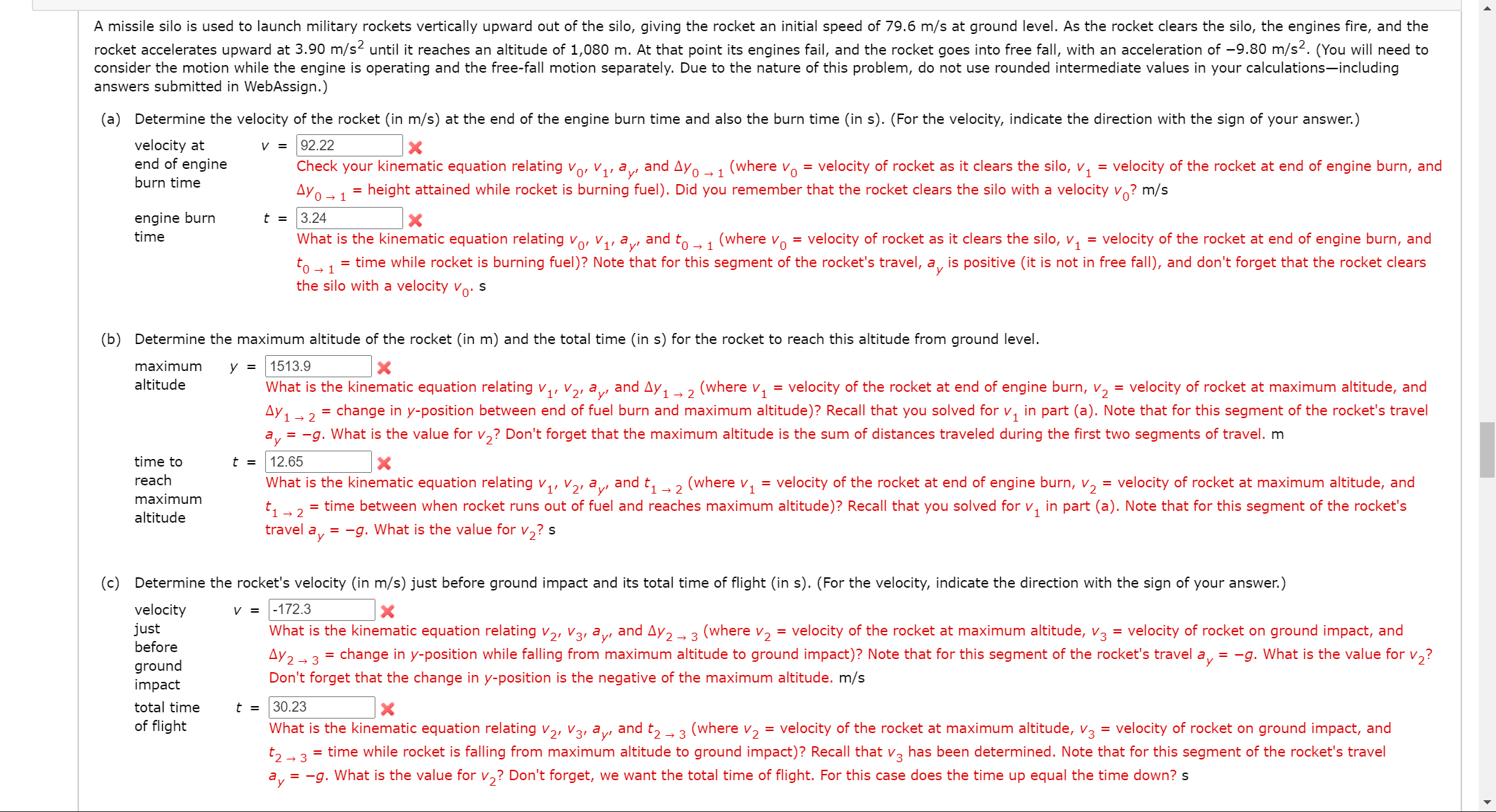A missile silo is used to launch military rockets vertically upward out of the silo, giving the rocket an initial speed of 79.6 m/s at ground level. As the rocket clears the silo, the engines fire, and the rocket accelerates upward at 3.90 m/s2 until it reaches an altitude of 1,080 m. At that point its engines fail, and the rocket goes into free fall, with an acceleration of -9.80 m/s². (You will need to consider the motion while the engine is operating and the free-fall motion separately. Due to the nature of this problem, do not use rounded intermediate values in your calculations-including answers submitted in WebAssign.) (a) Determine the velocity of the rocket (in m/s) at the end of the engine burn time and also the burn time (in s). (For the velocity, indicate the direction with the sign of your answer.) velocity at end of engine V = 92.22 Check your kinematic equation relating vo, V1, ay, and AYo → 1 (where velocity of rocket as it clears the silo, v, = velocity of the rocket at end of engine burn, and Vo = height attained while rocket is burning fuel). Did you remember that the rocket clears the silo with a velocity v? m/s = burn time Ayo → 1 * engine burn t = 3.24 time What is the kinematic equation relating vo, V, ay, and to →1 (where vo = velocity of rocket as it clears the silo, v, = velocity of the rocket at end of engine burn, and = time while rocket is burning fuel)? Note that for this segment of the rocket's travel, a, is positive (it is not in free fall), and don't forget that the rocket clears to - 1 the silo with a velocity vo- (b) Determine the maximum altitude of rocket (in m) and the total time (in s) for the rocket to reach this altitude from ground level. maximum у 3 1513.9 altitude What is the kinematic equation relating ,, V, ay, and Ay1 → 2 (where V1 = velocity of the rocket at end of engine burn, v, = velocity of rocket at maximum altitude, and change in y-position between end of fuel burn and maximum altitude)? Recall that you solved for v, in part (a). Note that for this segment of the rocket's travel Ay 1 = -g. What is the value for v,? Don't forget that the maximum altitude is the sum of distances traveled during the first two segments of travel. m → 2 ay time to t = 12.65 reach What is the kinematic equation relating v (1' V2' ayı and t1 - 2 (where v, = velocity of the rocket at end of engine burn, v, = velocity of rocket at maximum altitude, and maximum = time between when rocket runs out of fuel and reaches maximum altitude)? Recall that you solved for v, in part (a). Note that for this segment of the rocket's altitude → 2 travel ay = -g. What is the value for v,? s (c) Determine the rocket's velocity (in m/s) just before ground impact and its total time of flight (in s). (For the velocity, indicate the direction with the sign of your answer.) velocity just before v = |-172.3 What is the kinematic equation relating v,, V3, ay, and Ay,-3 (where v, = velocity of the rocket at maximum altitude, v3 = velocity of rocket on ground impact, and Ay 2→ 3 → 3 = change in y-position while falling from maximum altitude to ground impact)? Note that for this segment of the rocket's travel a, = -g. What is the value for V2? ground impact Don't forget that the change in y-position is the negative of the maximum altitude. m/s total time t = 30.23 of flight = velocity of rocket on ground impact, and = time while rocket is falling from maximum altitude to ground impact)? Recall that v, has been determined. Note that for this segment of the rocket's travel What is the kinematic equation relating v,, V3, ay, and t, 3 (where v, = velocity of the rocket at maximum altitude, V3 3 = -g. What is the value for v,? Don't forget, we want the total time of flight. For this case does the time up equal the time down? s
Displacement, Velocity and Acceleration
In classical mechanics, kinematics deals with the motion of a particle. It deals only with the position, velocity, acceleration, and displacement of a particle. It has no concern about the source of motion.
Linear Displacement
The term "displacement" refers to when something shifts away from its original "location," and "linear" refers to a straight line. As a result, “Linear Displacement” can be described as the movement of an object in a straight line along a single axis, for example, from side to side or up and down. Non-contact sensors such as LVDTs and other linear location sensors can calculate linear displacement. Non-contact sensors such as LVDTs and other linear location sensors can calculate linear displacement. Linear displacement is usually measured in millimeters or inches and may be positive or negative.

Trending now
This is a popular solution!
Step by step
Solved in 4 steps with 15 images


